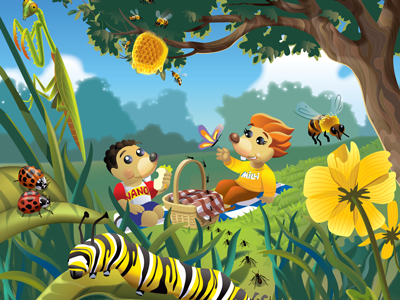By Regina Malczewski
Insects are found almost everywhere and in all environments. They inhabited the earth before the dinosaurs — and are still with us today! We know of about 1 million species, but biologists think there are over 90 times that many that we just haven’t yet classified! Insects make up more than 80% of all living things on earth, and altogether weigh 70 times more than all the people do. That’s a lot to buzz about!
We should probably talk about the word bug. It is used in different ways, and not all of them are accurate. True bugs are a type of insect that has a straw-shaped mouth and segmented antennae, like stink bugs and bedbugs. On the other hand, people often use the word bug to describe any kind of creepy-crawly pest, like spiders or centipedes … even though they are not insects at all!
Insect body parts have names a lot like ours — the head, thorax (chest), and abdomen. But insects are also very different from us in many ways, including:
- They have a hard outer skeleton, instead of an internal one like humans. All insects have six legs that have joints, compound eyes, and one pair of antennae. Creatures with different numbers of legs (such as spiders or centipedes) might look similar to insects, but are actually in a different group.
- They use their compound eyes to sense the world around them. Their eyes don’t see as well as ours, but they do provide sight in many directions at one time. Meanwhile, their antennae can sense touch, air motion, heat, sound, and chemical compounds that represent taste or smell.
- Insects usually start out as eggs that grow into worm-like larvae before they grow wings and take final form. The Splendor beetle spends 30 years in the larval stage!
Most insects have wings, and when they rub their wings together they make a buzzing sound. Dragonflies can fly up to 18 mph (29 km/h), and each of their four wings can move separately for astounding flight ability. They have the largest eyes of all insects — with 30,000 “facets” — that take up so much of the head they look like a helmet.
Insect chemistry can be “enlightening” (fireflies), sticky, destructive, or deadly (termites and insect venom). One benefit of insects is the beauty and wonder they provide. What would we do without butterflies? Their wings are very special: highly waterproof and made of tiny crystals that interact with light. The top hard shell of the jewel (wood-boring) beetle is similarly iridescent and is used for necklaces — and believe it or not, in some places, people even wear these insects as live decorations!
But insects are also busy doing more. Bees make honey and are responsible for pollinating $15 billion worth of U.S. crops every year. Insects are a protein-rich food and are even considered delicacies in some places. Some bugs provide chemicals or chemical mixtures that we use for items from lipsticks and nail polishes to dyes. Think of the silkworm, cultivated since 2,600 BC. Its silk has been harvested for use in sutures (also known as stitches), parachutes, and clothing. Post-harvest leftovers are used to feed livestock, and the worm itself is fried and available as street food in China.
Insects can also “bug” us — they eat crops, they can cause disease, and their bites or stings sometimes cause allergic reactions. Termites attack about 600,000 U.S. homes each year, and billions of dollars are spent either to prevent infestation or repair their damage. Their “spit” contains chemicals (enzymes) that break down the cellulose in wood, with help from microbes that live in their guts. Special chemicals called pheromones are used by some insects to attract mates or communicate. These chemicals can be used to trap or manage pests like the gypsy moth, which has destroyed more than a million acres of forest per year in the United States since 1980.
The next time you hear buzzing, consider the diversity and impact of all the insects that live on our planet. Important to chemistry, ecology, and so much more, let’s take a bow to bugs! Be both a chemist and an entomologist (a scientist who studies insects), and learn about the insects mentioned in this article and more in this issue of Celebrating Chemistry. And keep buzzing about insect chemistry for Chemists Celebrate Earth Week 2022!
Regina Malczewski, Ph.D. is a retired biochemist who worked at Dow Corning Corporation in Midland, MI.


